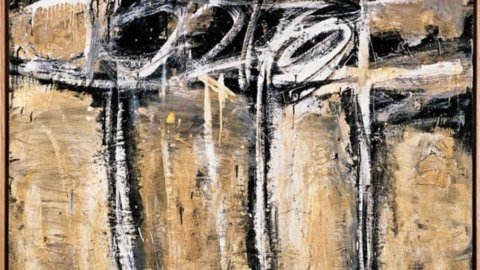Cy Twombly (Lexington, Virginia, 1928 – Rome, 2011) returns to Venice – where he has been present at the Biennale five times since 1964, the last of which in 2001 where he gets the Golden Lion – with an important exhibition monograph edited by Julie Sylvester and Philip Larratt-Smith.
The review, organized in collaboration with the Cy Twombly Foundation of New York, the scientific coordination of Gabriella Belli and the installation project by Daniela Ferretti, arrives at Ca' Pesaro like a precious cameo: the unprecedented testimony of a work that is regenerated with each of its appearances, in an emotional continuum, and of an artist who never ceases to amaze "for his extraordinary visual intelligence and acute sensitivity towards all forms of beauty, physical, natural and artistic”, as Philip Larratt-Smith writes in the catalog (ed. Damiani). Cy Twombly Paradise is an initiatory journey that crosses sixty years of the production of Twombly painter and sculptor and of his indefatigable creativity, which in Venice rediscovers - in a cultural context that always keeps the public's attention towards the great masters very high - a new perspective on the mysteries and revelations of Twombly's art. The work of Cy Twombly, who died in 2011, revolves around the universal themes of love, art, beauty and death, however the peculiarity of his artistic vision, his perspective of the world offer an extraordinarily original interpretation.
Like many of his generation, Twombly reacted against the dominant pictorial trend of Abstract Expressionism, but unlike others, directed towards Pop imagery and Neo-Dadaism, he synthesised the legacy and established techniques of abstraction gesture and the tradition of European painting. The innovative use of language, the wide range of allusions and references open his work to history, literature and philosophy; blurring the boundaries between painting, drawing and writing, while preserving a high degree of abstraction. A love of the vernacular is counterbalanced by a sophistication and deep cultural knowledge. Indeed, his work fluctuates between opposite binomials: reason and passion, representation and abstraction, Apollonian and Dionysian, sexuality and intellect, past and present, imagination and observation, lucidity and frenzy. Therefore, the exuberant sexuality, the reference to an Arcadian past in which body and mind are harmoniously unified, the recurrence in the works of words, sentences, poems and, above all, the gestural abstraction of Twombly - who made drawings in the dark, has painted with his left hand, he has increased the extension of the brush, fixing it to long sticks, as a conscious strategy to forget his artistic training and lose control of the technical means - these are just some of the themes of his creative research, retraced in the monumental rooms of Ca' Pesaro.
In the exhibition, from the wall paintings on wood dated 1951, we reach, in a path full of visions and references, a selection of Twombly's latest works created in 2011, when the artist was at the physical limit of old age: eight canvases of gestural circles baroque, in yellow, red and orange on a bright green background (half margarita, half key lime); eccentric circular brushstrokes – among the artist's key motifs – narrow in some points and wider and freer in others, to generate “a sensation of radiant energy and controlled frenzy”. “His characteristic marks, intentionally eliding paintings, drawings and writings, coexist with the occasional drops, splashes and smudges left to drip on the surface, revealing his creative process”. Created a few weeks and even a few days before his disappearance, these shiny and hypnotic surfaces – four of which are exhibited on this occasion – were the last painted by the American artist. For Twombly art is the "earthly paradise", where the experiences and emotions of the past are recovered and transfigured in the present. Love in all its manifestations – erotic, intellectual, platonic, romantic, love of culture, love of life – is the animating principle of his paintings, drawings and sculptures. His art is the mysterious, perfect union between dream and vigil, unrecoverable past and present perceivable through the senses, intellectual ardor and ability to love: paradise reconquered.





